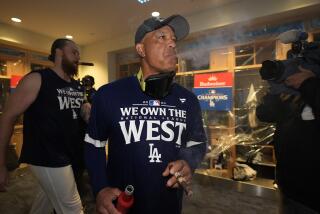THE MEDICINE HAT BLUE JAYS : This Rookie League Team Gets Heavy Dose of Losing
- Share via
Kevin Kandalaft walked off the mound after six solid innings on the wrong end of the score--again.
With Great Falls leading Medicine Hat, 2-0, Kandalaft was lifted for a pinch-hitter in the seventh. He retreated to the locker room to put ice on a tired left arm. His record was about to drop to 0-4.
Ice didn’t help that a bit.
In the eighth inning, Kandalaft returned to the dugout to find that Medicine Hat had taken a 4-3 lead and gotten him off the hook. Congratulations were in order.
Said Kandalaft: “One of the guys came up to me and said, ‘All right, you’re going to get a no-decision.’ ”
If you pitch for the Medicine Hat Blue Jays, a no-decision is a good decision.
At least it isn’t another loss.
Medicine Hat is at the bottom of professional baseball--literally, figuratively and absolutely.
A rookie league franchise for the Toronto Blue Jays located about 60 miles north of central Montana in Alberta, Canada, Medicine Hat has the dubious honor of having the worst record of them all, from the Atlanta Braves to the Durham Bulls.
The Blue Jays are 12-54 and in last place in the Northern Division of the Pioneer League. Twelve and Fifty-Four. That’s a .182 winning percentage or about one victory per week since the season began in June. The league record for fewest victories is 16.
The Blue Jays are a team in a no-win situation. The roster is composed mostly of players right out of high school, playing against teams stocked with college-level talent.
They have been overmatched.
But, at times, people have wondered whether the Blue Jays were just plain bad.
“At one point our radio announcer turned off his microphone in the middle of a game and told us ‘This is the (worst) team I’ve ever seen,’ ” said Dean Linden, the team’s 20-year-old general manager. “I took offense, but I really couldn’t disagree.”
On opening day, every team is a contender. It took less than three weeks for people to realize Medicine Hat was not.
The Blue Jays opened the season with three losses in Billings, Mont. They returned home to lose three more to Helena, Mont. A pattern was forming.
“We were getting crushed almost every night,” said Kandalaft, who played at UC Irvine from 1985-88. “I knew we would get a win, the law of averages was with us. But when?”
With each loss, a little more panic set in.
“The first eight just snuck up on us, then it hit,” said Linden, who is the youngest general manager in baseball. “It was tough watching the coaching staff rack their brains for a solution, but we just kept losing.”
Something had to be done.
Linden could do nothing about player personnel; those decisions are made in Toronto. However, it was his job to promote the Blue Jays to the public and put people in the stands.
An 0-8 team is a tough sell.
“We were the last story on the sports report every night,” Linden said. “A city the size of Medicine Hat (approximately 32,000) should be excited about its baseball team. It was my job to draw the attention of the sporting community.”
After loss No. 8, Linden hit on an idea. He would sleep on the field until the Blue Jays won.
As a promotional tool, it was a coup. Not only were the Blue Jays the lead story on the evening news that night, but pictures of Linden camping on third base at Athletic Park made newspapers around the country.
But Linden didn’t realize what he was in for; he became a hostage of his own team. The Blue Jays kept losing.
“The first night there was a tornado warning and the wind blew the tent away a couple times,” Linden said. “I’m not much of a camper to begin with, so when the sprinklers came on and soaked me, I was not very happy.”
Word of Linden’s vigil reached the team, which was playing in Great Falls, Mont.
“It was just a rumor circulating through the league,” said pitcher Jeff Mooney, a Westminster High School graduate. “But knowing Dean, we believed it.”
When the Blue Jays returned home, most of the team went out to the field to see for themselves. At 5 a.m., Linden looked out from his tent and saw almost an entire baseball team looking in.
“Dean hadn’t shaved in four or five days and he was wearing two or three sweat shirts,” Mooney said. “He was a mess.”
The Blue Jays continued to lose at home. Linden’s tent was moved from third base to the left-field corner.
There he remained, unless needed in the press box.
“He was right next to the bullpen and would sit in a beach chair and watch the game,” Mooney said. “It got to a point where we wanted to get a win just to get the guy out of that tent.”
After eight nights of sleeping in the not-so-great outdoors, Linden was reprieved. The Blue Jays defeated Billings, 6-4, in the first game of a doubleheader to run their record to 1-16.
They lost the second game.
“It was frustrating to watch these guys, they were trying so hard,” Linden said. “Something would go wrong and our players would look at each other like, ‘Why is this happening to us.’ ”
Every June, the Toronto organization sends a new batch of players to Medicine Hat. Rarely does a player stay there more than a season.
Only five players on this year’s team played in college. The rest have only high-school experience. Seven of those came from the Dominican Republic and could not speak English, which has made for some awkward moments.
Mooney, a reliever, remembers early in the season when Juan Jiame, the catcher, came to the mound for a conference. They immediately realized they had a problem.
“He couldn’t speak English, and I didn’t know any Spanish,” Mooney said. “There was a lot of sign language and sentences like, ‘Me throw ball.’ ”
Toronto’s philosophy is different from the rest of the Pioneer League parent teams. It’s the primary reason Medicine Hat has finished in last place the past five seasons.
Most of the college talent drafted by Toronto is sent to Class-A St. Catherines in the New York-Penn League. The younger kids go to Medicine Hat.
“By and large the rest of the (Pioneer) league is older and more experienced,” said Gord Ash, Toronto’s director of player personnel. “You want all your teams to win, but development is just as important.”
For the most part, the team’s pitchers are older and have college experience, such as Kandalaft and Mooney, who played at Cypress College for two years and at Chapman College for two more. However, starting pitchers are limited to 100 pitches per game.
“You don’t want a kid throwing 150-200 pitches and blowing his arm out,” said Ralph (Rocket) Wheeler, Medicine Hat’s manager. “A kid will tell you he’s feeling fine, but you know when he’s tiring. You have to protect them.”
Even at the cost of a game. Earlier this month in Salt Lake City, Rick Nowak had a 4-hit shutout through six innings when he reached the 100-pitch limit.
“They brought in a reliever who couldn’t put out a gas fire,” Dave Baggott, Salt Lake City’s general manager, said. “We buried them.”
Marketing such a team has been difficult. Selling tickets is even harder (the Blue Jays average about 400 fans per game). Yet, Linden has come up with some unique promotional ideas.
In July, there was “Sundae at the Park.” It featured a 150-foot banana split, which was built along the third-base line. Kids were invited onto the field to eat the sundae.
In August, Linden held a “Dash for Cash.” Four contestants were picked from the stands and sent to second base. Linden sprinkled $500 around home plate and the four fans had to run toward home, either by way of first or third base, to get to the money.
“It was hilarious to see these guys in business suits rolling around in the dirt and grass, stuffing money in their pockets,” pitcher Chris Kerr said. “To tell you the truth, some of us wanted to join in.”
Said Kandalaft: “If you take away our not-so-glorious record, we’ve had a lot of fun. If we were winning, it would be scary how much fun we’d be having.”
In July, many of the players went together to see “Bull Durham,” a movie about life in the minor leagues with a less-than-successful team. It was like watching their own story, according to Kandalaft.
“It was fun to watch these guys giggling at the things in the movie,” Linden said. “I could hear them say, ‘I’ve done that.’ It was a learning experience.”
But maybe a bit too educational.
In the film, the Durham Bulls, mired in a losing streak, flooded the field to postpone a game. Shortly after seeing the film, a game against Billings was rained out.
Linden was suspicious.
“I asked the guys about it and got a lot of snickers in return,” he said.
Kandalaft was evasive when questioned about alleged sabotage.
“Let’s just say it was well timed,” he said.
Fun is fun, but losing isn’t. The team’s frustration reached its peak in early August.
With 6 victories in 41 games, the Blue Jays were tired of losing and felt a lack of respect from other teams. They knew they were weren’t the best team, but didn’t like having their noses rubbed in it.
At Salt Lake City, the Blue Jays let their feelings be known with a bench-clearing fight. It started when Mooney hit outfielder Jeff Allison with a pitch, but its origins went back a week earlier when the Gulls were in Medicine Hat.
“The guy (Allison) was on second base and was blatantly giving signs to the batter,” Kandalaft said. “That happens all the time in baseball, but you don’t put it in the other team’s face.”
Kandalaft also said that Allison had been bad-mouthing the Blue Jays the night before, which Allison denies.
However, Allison admitted signaling to the batter. Before one pitch he even yelled out, “Look for it outside.” But he denied trying to show up the Blue Jays.
“Everyone tips off hitters when you’re at second, we just didn’t have a subtle way of doing it,” Allison said. “I apologized to their manager when they got to Salt Lake City the next week.”
The matter might have died if Allison hadn’t stolen second base with the Gulls leading by eight runs. That was the final insult.
On Allison’s next at-bat, Mooney threw two pitches inside, then hit Allison with the third.
“You can throw at me once--that’s baseball,” Allison said. “Twice is a gray area. Three times is ridiculous.”
Allison started toward the mound, but was restrained by the plate umpire. Mooney decided to meet him halfway.
“I was kind of surprised at first,” Mooney said. “I was sending him a message, but I really wasn’t trying to hit him.”
Not only did both benches and bullpens participate in the fight, but Medicine Hat’s Tim Hodge, who had been in the locker room icing a sprained ankle, rushed out to join the melee.
It took 12 minutes for umpires to restore order and another 20 to decide who should be ejected. Mooney and Allison were gone, plus six other players.
“It was pretty bad fight,” Kandalaft said. “Fortunately, no one got hurt. But there were some bloody faces. There were even some fans who threw beer on us.”
After the game, Salt Lake City officials kept the Medicine Hat team in its locker room for 30 minutes as a precaution.
“The fans and players leave through the same exit,” Baggott said. “I didn’t want another incident, so I threw a case of beer in their locker room and told them to stay put.”
With time to kill, the Blue Jays held a team meeting. They discussed the season and aired their feelings.
“The fight was the first time we’d stood together as a team,” Mooney said. “Everybody went out and protected each other instead of playing for themselves. We were a team.”
Said Kandalaft: “In all honesty, nothing brings a team together like a fight . . . except maybe a rainout.”
Since the fight, the Blue Jays have played better. They have even managed to win a few games with a record of 5-12 over the last 2 1/2 weeks.
All five victories came against Butte, Mont., which leads the Southern Division.
“All of a sudden we’re moving runners over, coming up with the good play,” Kandalaft said. “Hell, we’re even making the routine play.”
Kandalaft is 2-1 in his last four starts and has lowered his earned-run average to 3.59, eighth best in the league. He threw a shutout against Butte last week.
In that game, the Blue Jays scored seven runs in the first inning and went on to win, 16-0.
“It was nice to beat up on somebody,” Kandalaft said. “We’d been on the other end of it enough.”
Traditionally, Medicine Hat always plays better at the end. Players mature and develop. The team jells.
“We have some talent on this team,” said Wheeler, who was a player in the Toronto organization for eight years. “Eleven guys from this team are going to the instructional league. . . . That’s a pretty good nucleus, even if the record doesn’t show it.”
Kandalaft said the team has made plans for a reunion before spring training next year. It will be chance to reminisce before going their separate ways.
“I can’t say what I’ll want to remember from this season,” Mooney said. “I know it was a great bunch of guys, and I’ll always remember them. But the games, I can’t remember them now, just that most of them ended the same way.”
More to Read
Go beyond the scoreboard
Get the latest on L.A.'s teams in the daily Sports Report newsletter.
You may occasionally receive promotional content from the Los Angeles Times.











